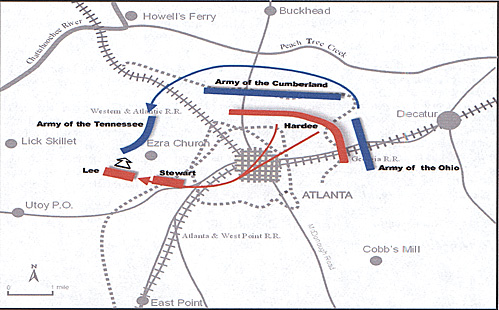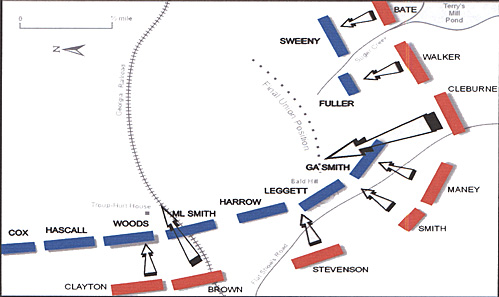Before Hardee and Stewart threw their men at Thomas south of Peachtree Creek, the first civilian casualty in the struggle for Atlanta lay dead at the corner of Ivy and East Ellis streets. At 1 p.m., a shell from a 20-pound Parrott of James McPherson's artillery had killed a little girl. His Union army was a mere two and a half miles away, and there was nothing in front of it, nothing of any substance that is, only cavalry. Luckily for Atlanta, McPherson was being overly cautious, as he was expecting to be attacked at any moment. This idea originally came from Sherman, but McPherson was capable of dreaming up his own devils, and he would not push any nearer to the city for the time being.
During the early hours of July 21, the troops of Cleburne's division started to occupy the rifle-pits abandoned by the Rebel cavalry. The gate to Atlanta was beginning to close for McPherson, and would need a mighty shove if it were to be opened again. McPherson contented himself with long-range artillery fire into the city.

John Bell Hood determined that he had been presented with another golden opportunity to stop the Federals. North of the city,
Thomas was licking his wounds after the battle of the previous day. Wheeler, Hood's cavalry commander, reported that McPherson's left flank was "in the air." In order to take advantage of this and turn his attention east of the city, Hood needed to disengage his army and move it swiftly across the city, positioning it to strike McPherson before the Yankees realise what is happening. Then, he could go back and finish off Thomas.
Hood's plan this time was to pull back Stewart and Cheatham to the inner defences, while Hardee and Wheeler circled around to Decatur to attack the Union rear. Once McPherson was pinned and had turned to face Hardee, Cheatham would then attack while Stewart prevented any interference from Thomas to the north. Once again, Hood took great care in briefing his corps commanders. Needless to say, such a complex plan did not go smoothly, as Stewart's men moved too far and had to set about improving their meagre defences. Cheatham's men could not disengage until after midnight, when it became obvious that the march to Decatur was now out of the question. Hood amended his plan so that Hardee would now only go half way and attack the Federals from the Cobb's Mill area at dawn. Sherman, meanwhile, was totally confused. Having received reports that the Confederates had withdrawn from their lines, he jumped to the conclusion that Hood was retreating and began to organise his march into Atlanta.
At dawn on July 22, Hood, at his headquarters on the eastern edge of Atlanta, waited in vain for the sound of Hardee's guns. However, Hardee was still marching into position, his weary divisions not ready to attack anyone. On reaching Cobb's Mill, Hardee, with help from Wheeler and locals, decided that he had gone far enough. He believed that there were no Union forces to his front, and therefore, he gave orders for his divisions to form up and move north. Walker lodged a complaint that the country in front of him would slow him down; however, Hardee had delayed long enough and ordered him to continue as per his orders. Meanwhile, Sherman had informed McPherson to halt any forward movement, as he now knew that the Confederates were not leaving the city after all. However, unlike Sherman, McPherson could not shake the feeling that he was going to be attacked, so at the last moment, he ordered Sweeny's division, reinforced by another brigade, to safeguard his extreme left. This would prove to be one of the luckiest interventions in the campaign.
Around noon, Hardee's corps was at last within striking distance of McPherson's line, having navigated briar patches, swamps, and a large impassable water feature known as Terry's Mill Pond. The first shot of the battle killed General Walker as he eventually got his first sight of the Union position. Thereafter, the firing became general and swelled as the battle was joined. Bate's depleted 1,200-man division, brittle after its losses during the campaign and exhausted from its floundering at Peachtree Creek, hit Sweeny, but broke and fled. Walker's division also made a half-hearted attack, which was halted by determined Yankee resistance. Moreover, Wheeler, whose cavalry should by now have been causing havoc in the Federal rear, was stalemated at Decatur.

At this critical moment, Pat Cleburne's elite division reached the front, and headed for a large gap in the Union line. General James McPherson was in that gap, and was felled by a bullet from the 5th Confederate "Regiment", strength ninety-one men.
Clebume's lead brigades were held up in a vicious fight with Hall's Federal brigade, but the position was eventually turned and the Yankees retreated, albeit grudgingly. Sadly for Hood's cause, Cleburne's division attacked piecemeal, and although fighting bravely, it eventually ran out of steam. The Union line, battered and bruised, maintained its integrity. The time was now 3 p.m. Hood, disappointed, moved his headquarters back to the rail depot in the city, where at 4 p.m. he received the startling news that Hardee was now pushing the Federals and advancing once again. Govan and Vaughan's brigades had succeeded in breaching the Federal defences. Faced with encirclement, the Yankees had begun to retreat. Elated, Hood now ordered Cheatham to attack.
As usual, there was no great hammer blow against the Federal line, but merely more piecemeal attacks, Stevenson's division and the Georgia Militia were stopped in their tracks. Some of Brown's brigades found a weak link in the Union defences as they probed along the line of the Georgia Railroad. Brown himself had no control over what was happening and was completely out of his depth. Sherman, meanwhile, was galvanized, rounding up 28 cannon to plug the tear in his line. Like Wellington at Waterloo, he ordered everything he had to move in front of this possible disaster. Before the Federals can strike, someone ordered the Confederate spearhead to withdraw, and astonishingly, they retreated when they should have been reinforced, just as victory beckoned. The weary, disheartened Rebels returned to the Yankee works they had previously overrun. Clayton's division wandered around aimlessly behind the front line, supposed to be attacking the Bald Hill. However, conflicting orders and the confusion of battle had combined to halt its attack before it had begun. Subsequently, Federal counterattacks restored their line, and by darkness, they were back in their old entrenchments.
All this time, Hardee had been pushing north and aiming for the Bald Hill. Govan's Arkansans fought hand to hand on the slopes, but it was all to no avail - desperate defending and exhaustion all play their part, and the Rebels can do no more. Both sides settled down after a long bloody day.
Due to the bravery and courage of certain brigades and commanders, Hood had almost achieved the victory he was looking for. Unfortunately, the Federals have also fought with tenacity, and in the end had managed to deny him a victory he so desperately needed. The butcher's bill for July 22 was high. Confederate casualties were approximately 5,500, most from Hardee's corps, while the Federals reported 3,722 killed, wounded, or missing. Hood's army was worn out, and as usual, the result of the battle brought about recriminations in the high command. The curse of the Army of Tennessee had returned.
WARGAME
This scenario deals with the action against McPherson's left flank. The battle starts at Noon and continues until the onset of darkness at 7:15 pm. Due to the small size of many regiments, I recommend merging units with 200 men or less. The 97th Indiana and 12'h Illinois had at least one company armed with repeating rifles. Therefore, one stand may be so designated. Battery F, 2"d United States Artillery, was on the southern portion of the battlefield, but when ordered into position, it took a road that led to it being captured by the Confederates. Therefore, as it played no part in the action, I have decided not to portray them on the battlefield. Carter's Brigade of Cheatham's Division was given to Cleburne at the last minute just before the attack. Therefore, I would give the Confederate commander the choice of leaving the brigade with Cheatham, where it would enter behind Strahl, or having it arrive with Cleburne- Walker's division cannot move to flank Smith, as Sweeney was its original target and this must be maintained, at least for the start of the game.
I have no idea which Confederate artillery units lent support for this attack. Since there was support as evidenced from Union reports, I have therefore allowed for several batteries on this part of the battlefield
DEPLOYMENT
In some cases, I have already amalgamated Rebel units on the map in order to fit the brigades into their assault areas. Feel free to amend these formations if you wish, but they must deploy within that part of the battlefield as shown. Bates' Division arrives at point `A' on turn one, and can charge on table if the player so wishes. The division deploys from left to right: Finley, Tyler, Lewis. Skirmishers must lead the division. When amalgamated, the division will fit into the space provided. Cleburne arrives on turn two at `B' with Govan and Smith in the lead, on the left and right respectively. Lowrey follows on turn three. Carter will either appear behind Strahl on turn 2 or later, or behind Lowrey on turn 4. The Georgia Militia will enter at point `D' on any turn the player wishes. As for the Confederate artillery, this must be parceled out before the game begins. Done of it, as far as I know, was in the front line, at least to begin with. Therefore, no guns can move on table until turn four, apart from Anderson's, which moved with the Georgia Militia. These batteries can, however, fire from off table by marking a firing point on the map edge and adding six inches to the range.
The Federal reinforcements of Wangelin's brigade enter at `D' at 2 pm.
TERRAIN
This is mainly wooded, which, along with Sugar Creek, is broken terrain. Hasty works covered the Union line, except the front of Hall's brigade, which is considered light works, and Sweeny and Fuller, who are in the open.
VICTORY CONDITIONS
The Confederates must force a Union withdrawal by destroying the divisions of Sweeny and Smith. They can also claim a minor victory if they take and hold Bald Hill.
Hood at Atlanta 1864 Part 2
- Background and Campaign
Atlanta Order of Battle: Union
Atlanta Order of Battle: Confederate
Atlanta Map (105K)
Hood at Atlanta 1864 Part 1
- Background
The Campaign
Battle of Peachtree Creek
Peachtree Creek Wargame
Peachtree Creek Order of Battle: Union
Peachtree Creek Order of Battle: Confederate
Peachtree Creek Map (114K)
Back to Table of Contents -- Charge! # 4
Back to Charge! List of Issues
Back to MagWeb Master Magazine List
© Copyright 2004 by Scott Mingus.
This article appears in MagWeb.com (Magazine Web) on the Internet World Wide Web.
Other articles from military history and related magazines are available at http://www.magweb.com